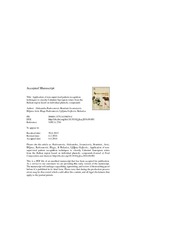Приказ основних података о документу
Application of non-supervised pattern recognition techniques to classify Cabernet Sauvignon wines from the Balkan region based on individual phenolic compounds
| dc.creator | Radovanović, Aleksandra | |
| dc.creator | Jovančićević, Branimir | |
| dc.creator | Arsić, Biljana | |
| dc.creator | Radovanović, Blaga | |
| dc.creator | Gojković-Bukarica, Ljiliana | |
| dc.date.accessioned | 2019-09-03T08:11:10Z | |
| dc.date.available | 2017-04-04 | |
| dc.date.issued | 2016 | |
| dc.identifier.issn | 0889-1575 | |
| dc.identifier.uri | https://cherry.chem.bg.ac.rs/handle/123456789/3358 | |
| dc.description.abstract | Phenolic compounds in sixteen Cabernet Sauvignon wines from different wine-growing sub-regions in the Balkan region were investigated using HPLC with DAD and fluorescence detector and spectroscopic analysis, as well as statistical PC/F and cluster analysis. The HPLC analysis of investigated red wines showed that the content of total hydroxybenzoic acids, detected at 280 nm, was the highest in wines from Tikves wine-growing subregion, Macedonia (127-140 mg L-1). Total hydroxycinnamic acids, detected at 320 nm, were the highest in wines from Zupa wine-growing subregion, Serbia (43-45 mg L-1). The concentration of total flavonoids (flavan-3-ols, flavonols, flavons and flavanon), detected at 280, 360 and 322/275 nm, respectively, was the highest in wine from Katarzyna Estate wine-growing subregion, Bulgaria (167 mg L-1). Finally, the concentration of total anthocyanins, detected at 520 nm, was the highest in wine from Sumadija wine-growing subregion, Serbia (1463 mg L-1). The results of PCA and cluster analysis together confirmed that the content of phenolic compounds in Cabernet Sauvignon wines depends on agro-climatic factors, oenological practice in different wineries and the growing season in the Balkan region that were investigated. The areas in the Balkan region in this study with similar agro-climatic characteristics showed shorter clustering distance, indicating similar phenol profiling in the red wines tested. (C) 2016 Elsevier Inc. All rights reserved. | en |
| dc.publisher | Academic Press Inc Elsevier Science, San Diego | |
| dc.relation | info:eu-repo/grantAgreement/MESTD/Technological Development (TD or TR)/34012/RS// | |
| dc.relation | info:eu-repo/grantAgreement/MESTD/Technological Development (TD or TR)/31020/RS// | |
| dc.relation | info:eu-repo/grantAgreement/MESTD/Basic Research (BR or ON)/174007/RS// | |
| dc.relation | info:eu-repo/grantAgreement/EC/FP7/204756/EU// | |
| dc.rights | embargoedAccess | |
| dc.rights.uri | https://creativecommons.org/licenses/by-nc-nd/4.0/ | |
| dc.source | Journal of Food Composition and Analysis | |
| dc.subject | Cabernet Sauvignon wines | en |
| dc.subject | Red wine | en |
| dc.subject | Phenolic compounds | en |
| dc.subject | Balkan subregions | en |
| dc.subject | Statistical analysis | en |
| dc.subject | Principal component analysis | en |
| dc.subject | Food analysis | en |
| dc.subject | Food composition | en |
| dc.subject | Wine consumers | en |
| dc.title | Application of non-supervised pattern recognition techniques to classify Cabernet Sauvignon wines from the Balkan region based on individual phenolic compounds | en |
| dc.type | article | |
| dc.rights.license | BY-NC-ND | |
| dcterms.abstract | Јованчићевић, Бранимир; Радовановић, Блага; Радовановић, Aлександра; Aрсић, Биљана; Гојковић-Букарица, Љилиана; | |
| dc.citation.volume | 49 | |
| dc.citation.spage | 42 | |
| dc.citation.epage | 48 | |
| dc.identifier.wos | 000377835900005 | |
| dc.identifier.doi | 10.1016/j.jfca.2016.04.001 | |
| dc.citation.other | 49: 42-48 | |
| dc.citation.rank | M21 | |
| dc.description.other | This is peer-reviewed version of the following article: Radovanovic, A.; Jovancicevic, B.; Arsic, B.; Radovanovic, B.; Bukarica, L. G. Application of Non-Supervised Pattern Recognition Techniques to Classify Cabernet Sauvignon Wines from the Balkan Region Based on Individual Phenolic Compounds. Journal of Food Composition and Analysis 2016, 49, 42–48. [https://doi.org/10.1016/j.jfca.2016.04.001] | |
| dc.description.other | Supplementary material: [http://cherry.chem.bg.ac.rs/handle/123456789/3359] | |
| dc.type.version | acceptedVersion | en |
| dc.identifier.scopus | 2-s2.0-84963735596 | |
| dc.identifier.fulltext | https://cherry.chem.bg.ac.rs/bitstream/id/14677/Application_of_non_acc_2016.pdf |


